Your vehicle is equipped with a spare tire. The flat tire can be
replaced with the spare tire.
| WARNING ■If you have a flat tire
Do not continue driving with a flat tire.
Driving even a short distance with a flat tire can damage the tire
and the
wheel beyond repair, which could result in an accident. |
Before jacking up the vehicle
- Stop the vehicle in a safe place on a hard, flat surface.
- Set the parking brake.
- Shift the shift lever to P.
- Stop the engine.
- Turn on the emergency flashers.
Location of the spare tire, jack and tools
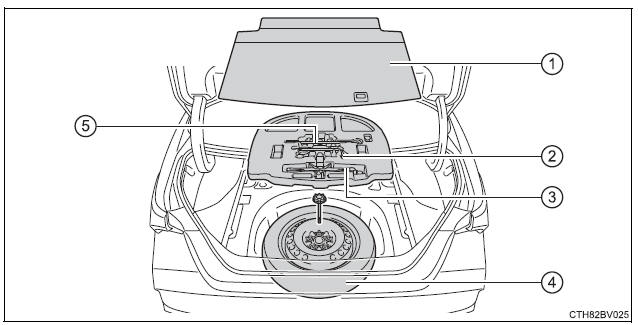
- Luggage floor cover
- Wheel nut wrench
- Jack
- Spare tire
- Jack handle
| WARNING ■Using the tire jack
Observe the following precautions.
Improper use of the tire jack may cause the vehicle to suddenly fall
off
the jack, leading to death or serious injury.
|
| NOTICE ■To prevent damage to the vehicle when using a
jack
When jacking up the rear of the vehicle,
make sure not to position the jack
under the bracket shown in the illustration
near the rear jack point, as the
vehicle body may be damaged.
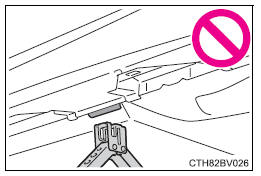 |
Taking out the jack
1. Lift up the hook of the luggage
floor cover on the trunk floor.
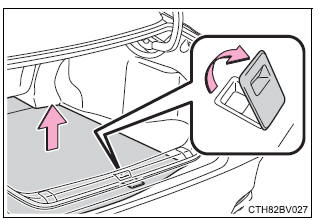
2. Secure the luggage floor cover
using the hook provided.
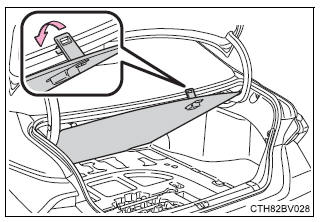
3. Remove the jack.
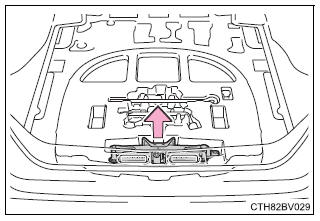
Taking out the spare tire
1. Lift up the hook of the luggage
floor cover on the trunk floor.
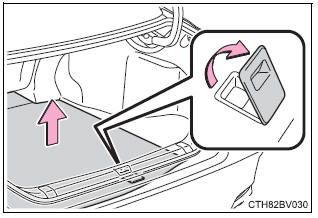
2. Secure the luggage floor cover
using the hook provided.
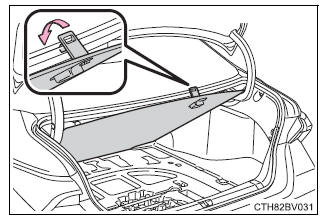
3. Remove the tool tray.
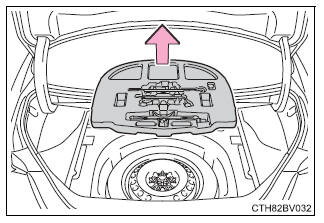
4. Loosen the center fastener that
secures the spare tire.
When taking out or stowing the
spare tire, make sure to firmly
hold opposite end of the tire.
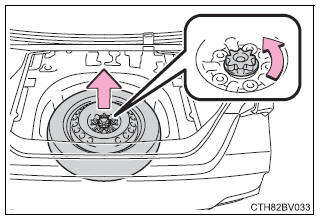
| WARNING ■When storing the spare tire
Be careful not to catch fingers or other body parts between the
spare
tire and the body of the vehicle. |
Replacing a flat tire
1. Chock the tires.
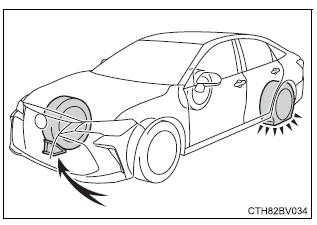
| Flat tire |
Wheel chock positions |
| Front |
Left-hand side |
Behind the rear right-hand side tire |
| Right-hand side |
Behind the rear left-hand side tire |
| Rear |
Left-hand side |
In front of the front right-hand side tire |
| Right-hand side |
In front of the front left-hand side tire |
2. Slightly loosen the wheel nuts
(one turn).
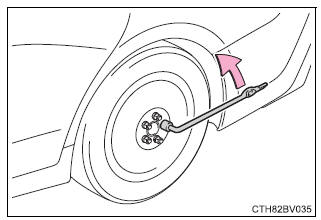
3. Turn the tire jack portion "A" by
hand until the notch of the jack
is in contact with the jack point.
To prevent damage to the vehicle
when using the jack, position the
jack in the correct location.
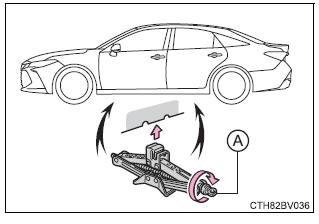
The jack point guides are located
under the rocker panel. They
indicate the jack point positions.
4. Assemble the jack handle.
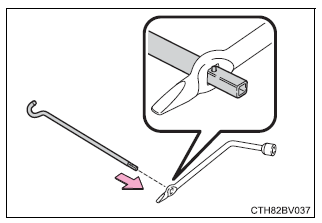
5. Raise the vehicle until the tire is
slightly raised off the ground.
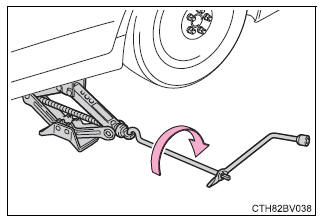
6. Remove all the wheel nuts and
the tire.
When resting the tire on the
ground, place the tire so that the
wheel design faces up to avoid
scratching the wheel surface.
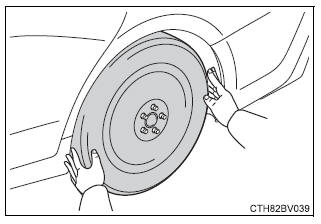
| WARNING ■Replacing a flat tire
- Do not touch the disc wheels or the area around the brakes
immediately
after the vehicle has been driven.
After the vehicle has been driven the disc wheels and the area
around
the brakes will be extremely hot. Touching these areas with
hands, feet
or other body parts while changing a tire, etc. may result in
burns.
- Failure to follow these precautions could cause the wheel
nuts to
loosen and the tire to fall off, resulting in death or serious
injury.
- Have the wheel nuts tightened with a torque wrench to 76
ft*lbf (103
N*m, 10.5 kgf*m) as soon as possible after changing wheels.
- Do not attach a heavily damaged wheel ornament, as it
may fly off
the wheel while the vehicle is moving.
- When installing a tire, only use wheel nuts that have
been specifically
designed for that wheel.
- If there are any cracks or deformations in the bolt
screws, nut
threads or bolt holes of the wheel, have the vehicle
inspected by
your Toyota dealer.
- When installing the wheel nuts, be sure to install them
with the
tapered ends facing inward.
|
Installing the spare tire
1. Remove any dirt or foreign matter
from the wheel contact surface.
If foreign matter is on the wheel
contact surface, the wheel nuts
may loosen while the vehicle is in
motion, causing the tire to come
off.
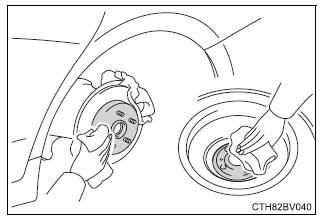
2. Install the tire and loosely tighten each wheel nut by hand by
approximately the same amount.
Tighten the wheel nuts until the
tapered portion comes into loose
contact with the disc wheel seat.
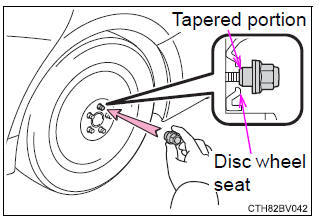
3. Lower the vehicle.
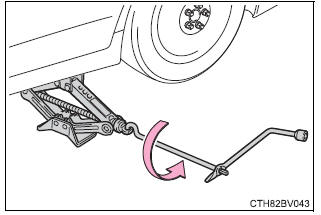
4. Firmly tighten each wheel nut
two or three times in the order
shown in the illustration.
Tightening torque:
76 ft*lbf (103 N*m, 10.5 kgf*m)
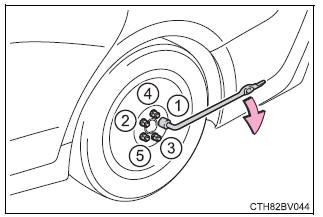
5. Stow the flat tire, tire jack and all tools.
■The compact spare tire
■When using the compact spare tire
As the compact spare tire is not equipped with a tire pressure warning
valve and transmitter, low inflation pressure of the spare tire will not be
indicated by the tire pressure warning system. Also, if you replace the
compact spare tire after the tire pressure warning light comes on, the light
remains on.
■When the compact spare tire is equipped
When driving with the compact spare tire installed, the vehicle height
will
be different than when driving with standard tires.
■If you have a flat front tire on a road covered with snow or ice
Install the compact spare tire on one of the rear wheels of the vehicle.
Perform the following steps and fit tire chains to the front tires:
1. Replace a rear tire with the compact spare tire.
2. Replace the flat front tire with the tire removed from the rear of the
vehicle.
3. Fit tire chains to the front tires.
| WARNING ■When using the compact spare tire
- Remember that the compact spare tire provided is
specifically
designed for use with your vehicle. Do not use your compact
spare tire
on another vehicle.
- Do not use more than one compact spare tires simultaneously.
- Replace the compact spare tire with a standard tire as soon
as possible.
- Avoid sudden acceleration, abrupt steering, sudden braking
and shifting
operations that cause sudden engine braking.
■When the compact spare tire is attached
The vehicle speed may not be correctly detected, and the following
systems
may not operate correctly:
- ABS & Brake assist
- VSC
- TRAC
- EPS
- Automatic High Beam
- Dynamic radar cruise control
with full-speed range
- LDA (Lane Departure Alert with
steering control)
- PCS (Pre-Collision System)
- Tire pressure warning system
- BSM (Blind Spot Monitor)
- Intuitive parking assist*
- Intelligent Clearance Sonar
(ICS)*
- Rear view monitor system*
- Toyota parking assist monitor
- Panoramic view monitor*
- Navigation system*
*: If equipped
■Speed limit when using the compact spare tire
Do not drive at speeds in excess of 50 mph (80 km/h) when a compact
spare tire is installed on the vehicle.
The compact spare tire is not designed for driving at high speeds.
Failure
to observe this precaution may lead to an accident causing death or
serious injury.
■After using the tools and jack
Before driving, make sure all the tools and jack are securely in
place in
their storage location to reduce the possibility of personal injury
during a
collision or sudden braking. |
| NOTICE ■Be careful when driving over bumps with the
compact spare tire
installed on the vehicle.
The vehicle becomes lower when driving with the compact spare tire
compared to when driving with standard tires. Be careful when
driving
over uneven road surfaces.
■Driving with tire chains and the compact spare tire
Do not fit tire chains to the compact spare tire.
Tire chains may damage the vehicle body and adversely affect driving
performance.
■When replacing the tires
When removing or fitting the wheels, tires or the tire pressure
warning
valve and transmitter, contact your Toyota dealer as the tire
pressure
warning valve and transmitter may be damaged if not handled
correctly.
■To avoid damage to the tire pressure warning valve and transmitters
When a tire is repaired with liquid sealants, the tire pressure
warning
valve and transmitter may not operate properly. If a liquid sealant
is
used, contact your Toyota dealer or other qualified service shop as
soon
as possible. Make sure to replace the tire pressure warning valve
and
transmitter when replacing the tire. |
|